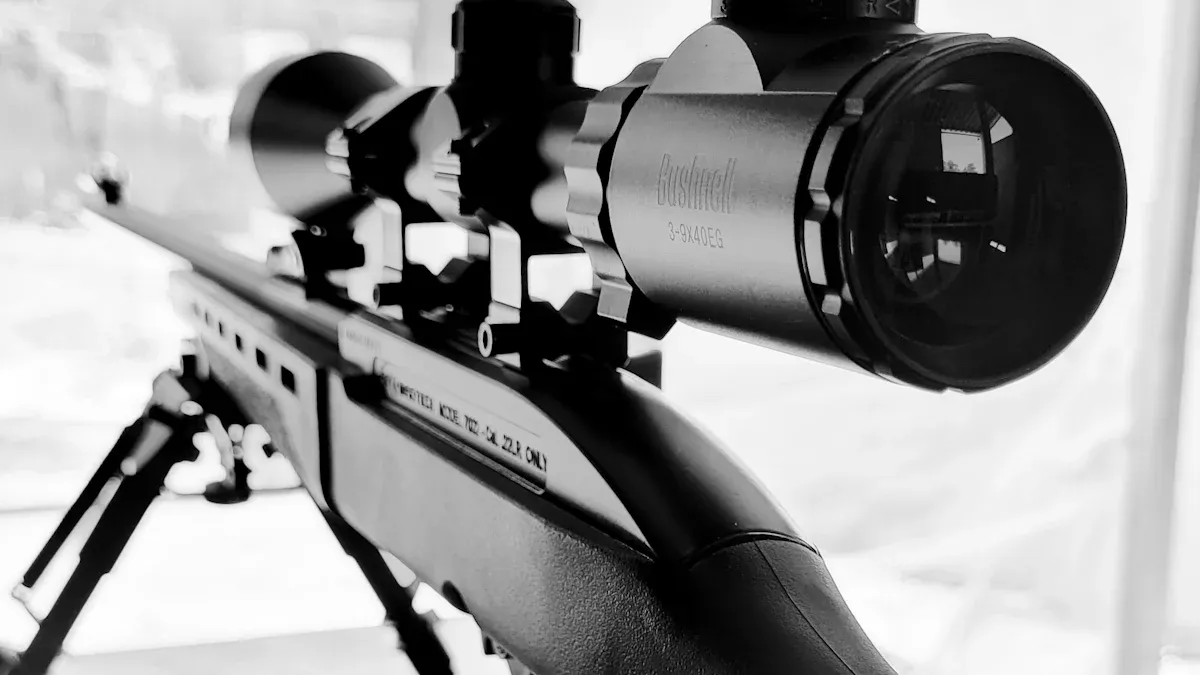
A rifle bipod is essential for improving stability and accuracy, especially with heavy barrel rifles weighing over 15 pounds. These rifles demand a sturdy support system to handle their weight. Finding the right bipod can be tricky, as not all models are built for such demands. A well-chosen bipod reduces shooter fatigue and enhances precision. Pairing it with other accessories, like a reliable rifle scope, ensures better results. Look for options that securely mount to your rifle’s Rail for optimal performance.
Key Takeaways
- Pick a bipod that can hold at least 145 lbs. This keeps heavy barrel rifles steady.
- Choose strong materials like aluminum or carbon fiber. These are tough and light to carry.
- Find bipods with legs you can adjust. This helps in different shooting situations.
Key Factors to Consider When Choosing a Bipod
Weight Capacity and Stability
When selecting a bipod for a heavy barrel rifle, weight capacity and stability are critical. A heavier bipod often provides better stability, which is essential for precision shooting. For example, competitive shooters benefit from a stable platform to maintain accuracy. On the other hand, hunters may prefer a lightweight option for easier portability. Materials like steel or aircraft-grade aluminum enhance stability and ensure the bipod can handle the weight of rifles over 15 pounds.
- Tip: Look for bipods that can support at least 145 lbs with minimal flex to ensure they can handle the torque of heavy barrel rifles.
Material and Durability
The material of a bipod directly impacts its durability and performance. Aircraft-grade aluminum and carbon fiber are excellent choices. Aluminum offers lightweight strength, while carbon fiber provides a balance of sturdiness and portability. These materials resist wear and tear, making them ideal for rugged environments. Steel, though heavier, adds extra stability for stationary shooting.
Note: Investing in a durable bipod ensures long-term reliability, even in harsh conditions.
Adjustability and Height Range
Adjustability is key for adapting to different shooting scenarios. A good bipod should offer variable leg heights and locking mechanisms for stability on uneven terrain. For instance, the CVLIFE Bipod provides height settings ranging from 6 to 9 inches, while the Adjustable Bipod offers spring-loaded legs with auto-lock features.
| Bipod Model | Height Range (inches) | Adjustability Features |
|---|---|---|
| CVLIFE Bipod | 6 to 9 | 5 Height Settings with Release Button |
| Adjustable Bipod | 6.5 to 9.5 | Spring-loaded Legs with Auto-lock |
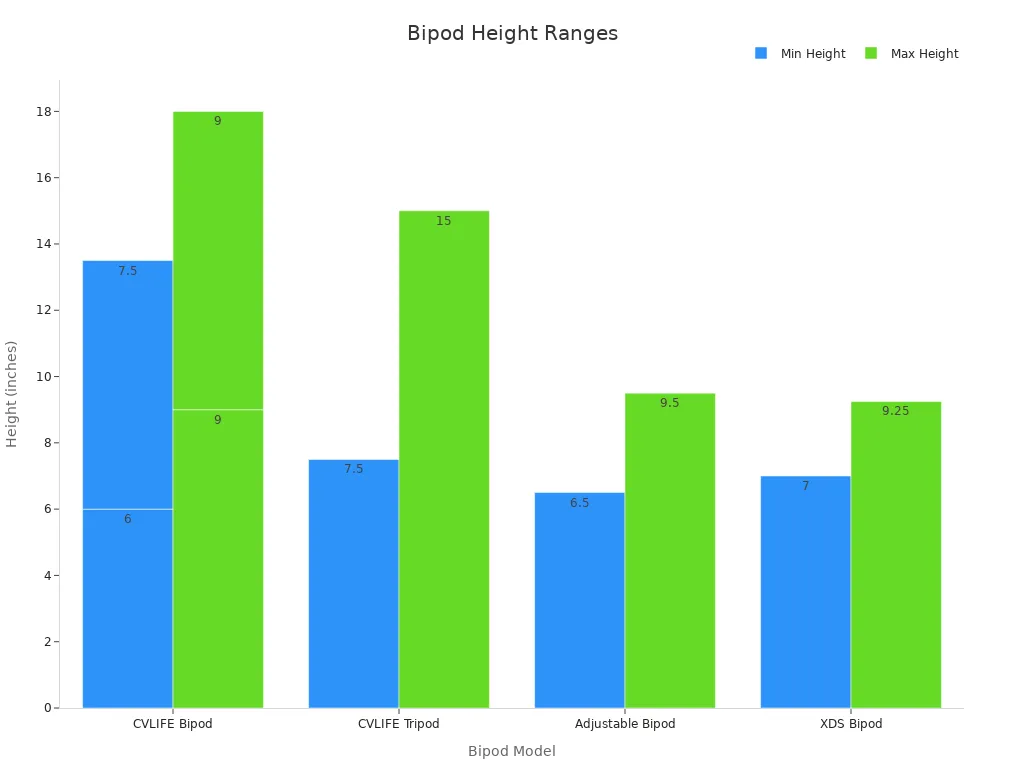
Mounting Options and Compatibility
A rifle bipod must be compatible with your rifle’s mounting system. Popular options include Picatinny and M-Lok rails. Some bipods also feature cant adjustments and symmetrical legs to counteract rifle torque. These features are particularly useful for heavy barrel rifles, ensuring a secure and stable attachment.
- Pro Tip: Check the weight of the bipod. Models under 20 ounces are ideal for maintaining balance without compromising stability.
Portability and Weight of the Bipod
Portability matters, especially for hunters who need to carry their gear over long distances. Lightweight bipods like the Javelin Lite (4.8 oz) are perfect for such scenarios. However, heavier models like the Valhalla Bipod (13 oz) provide better stability for precision shooting.
| Bipod Model | Weight (oz) | Weight (g) |
|---|---|---|
| Javelin Lite Bipod | 4.8 | 135 |
| Javelin Pro Hunt Tac | 7.6 | 215 |
| Valhalla Bipod | 13 | 373 |
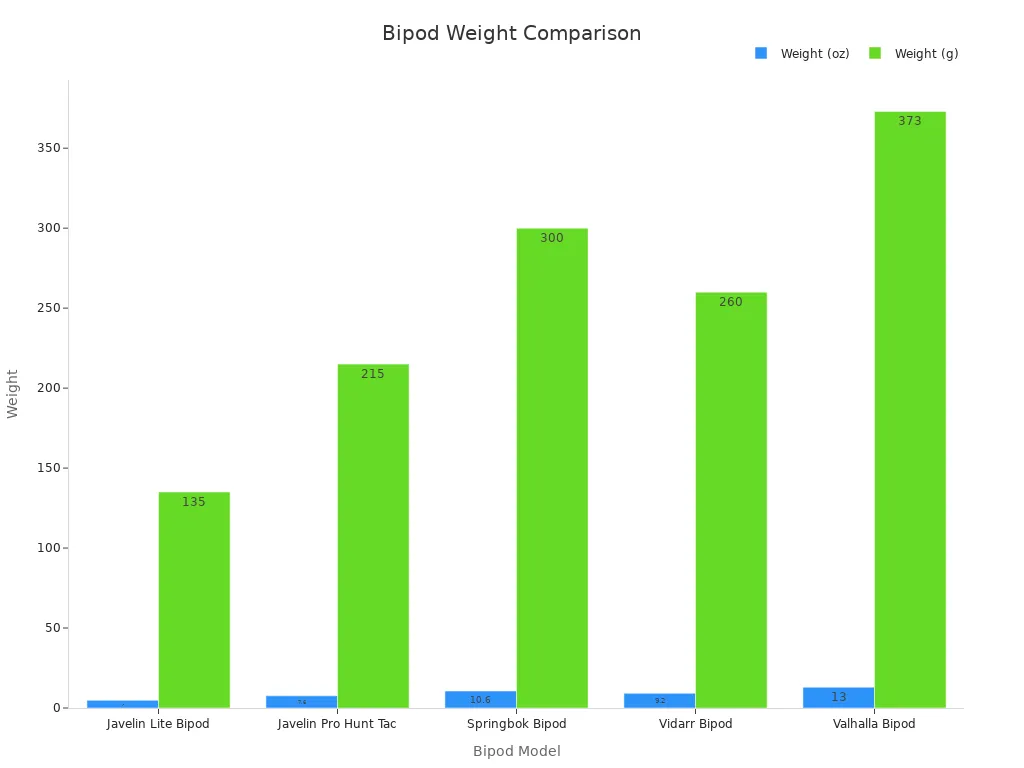
Top Recommended Bipods for Heavy Barrel Rifles Over 15lbs
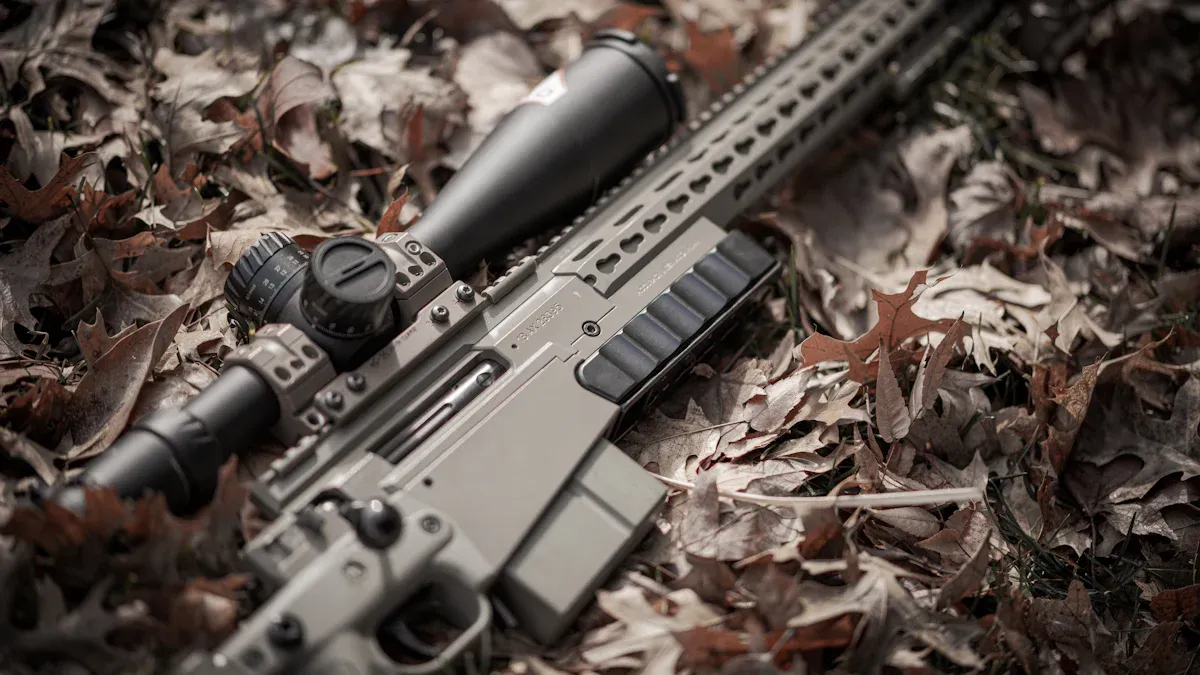
Atlas BT46-LW17 PSR Bipod – Features, Pros, and Cons
The Atlas BT46-LW17 PSR Bipod is a top-tier choice for heavy barrel rifles. Its robust construction and versatile features make it a favorite among precision shooters.
-
Features:
- Height range: 7.0 to 13.0 inches.
- Weight: 15.13 ounces.
- Made from T7075 aluminum for durability.
- Offers four leg positions: stowed back, 90 degrees down, 45 degrees forward, and stowed forward.
- Provides 15 degrees of preloaded pan and cant for smooth adjustments.
-
Pros:
- Performs well on various surfaces like dirt, grass, and gravel.
- Lightweight yet sturdy, ideal for heavy rifles.
- Adjustable legs ensure stability on uneven terrain.
-
Cons:
- Higher price point compared to other models.
- May require additional practice to master its full range of adjustments.
Harris S-BRM Bipod – Features, Pros, and Cons
The Harris S-BRM Bipod is a reliable option for shooters seeking durability and ease of use. It’s often praised for its performance in challenging conditions.
| Feature | Description |
|---|---|
| Quick Deployment | Spring-loaded legs allow rapid setup and retraction. |
| Compatibility | Attaches to rifles with sling studs, enhancing versatility. |
| Military Endorsement | Proven reliability, used in military operations. |
| Leg Extension | Adjustable from 6 to 9 inches in 1-inch increments. |
| Performance in Adverse Conditions | Functions well in mud and dust, showcasing durability. |
| Weight | Lightweight design for easy transport. |
-
Pros:
- Notched legs and swivel feature improve usability on uneven terrain.
- Ideal for prone shooting due to its height range.
- Durable and trusted by professionals.
-
Cons:
- Slightly more expensive than other models.
- Requires a ‘Pod Lock’ or ‘S’ Lock for better swivel tension control.
Accu-Tac HD-50 Bipod – Features, Pros, and Cons
The Accu-Tac HD-50 Bipod is built for extreme stability, making it perfect for heavy-duty rifles. Its rugged design ensures reliable performance in demanding situations.
-
Features:
- Heavy-duty construction for rifles over 15lbs.
- Adjustable legs for various shooting positions.
- Wide stance for maximum stability.
-
Pros:
- Handles recoil effectively, even with powerful calibers.
- Easy to set up and adjust.
- Excellent for long-range precision shooting.
-
Cons:
- Heavier than other bipods, which may affect portability.
- Bulkier design might not suit all shooting styles.
Spartan Precision Javelin Pro Hunt Bipod – Features, Pros, and Cons
The Spartan Precision Javelin Pro Hunt Bipod is a lightweight yet durable option, ideal for hunters who prioritize portability.
-
Features:
- Made from carbon fiber for a lightweight build.
- Magnetic attachment system for quick setup.
- Adjustable legs for uneven terrain.
-
Pros:
- Extremely portable, weighing just a few ounces.
- Quiet operation, perfect for stealthy hunting.
- Easy to attach and detach.
-
Cons:
- Limited height range compared to other models.
- Magnetic attachment may not feel as secure for some users.
Magpul Bipod for 1913 Picatinny Rail – Features, Pros, and Cons
The Magpul Bipod is a versatile and affordable option for shooters looking for a balance of quality and cost.
The lightweight design and robust construction make it suitable for various shooting scenarios. Users have praised its durability and consistent performance in harsh conditions. It’s easy to install and operates smoothly, making it a great choice for beginners and experienced shooters alike.
-
Pros:
- Affordable compared to premium models.
- Durable and reliable in tough environments.
- Simple installation process.
-
Cons:
- Limited adjustability compared to higher-end bipods.
- May not provide the same level of stability as heavier models.
How to Match a Bipod to Your Shooting Style
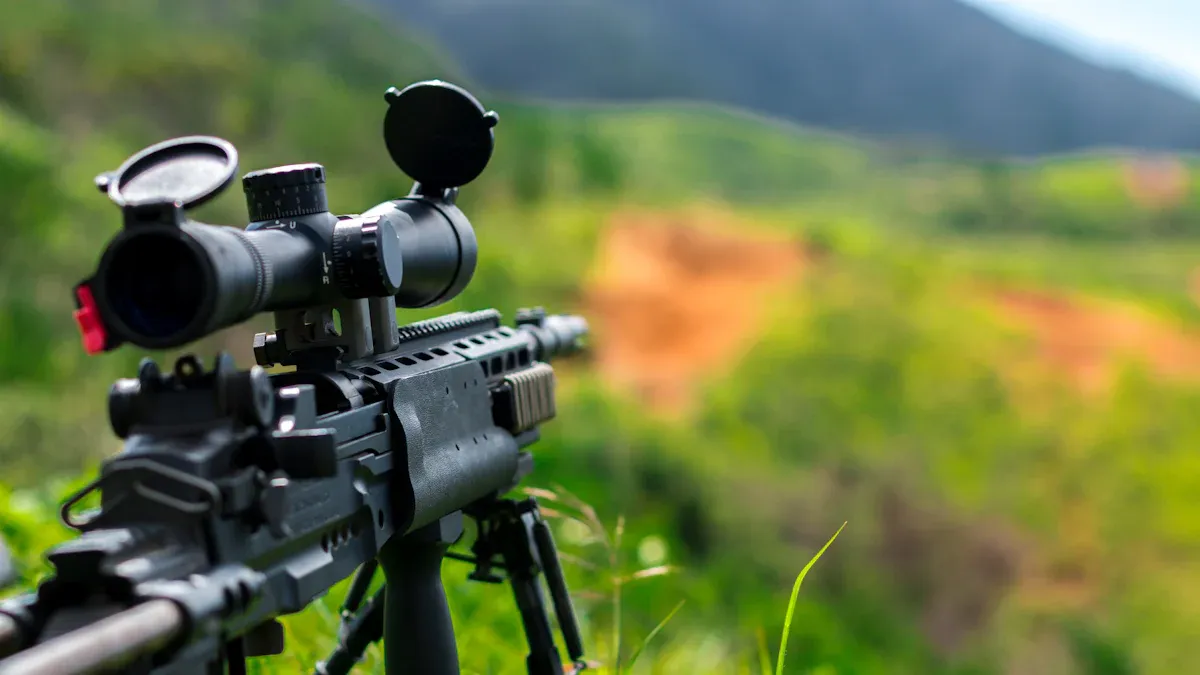
Prone Shooting
Prone shooting demands a stable and low-profile bipod to maintain accuracy. Many competitive shooters prefer sled-type bipods for this style, as seen in F-T/R events. These bipods provide a wider footprint, which enhances stability. Soft rubber feet, like those found on Atlas bipods, are ideal for gripping various surfaces. A wider stance, such as that offered by the Long Range Accuracy bipod, can also improve performance.
- Key Tips for Prone Shooting:
- Choose a bipod with a low height range (6-9 inches).
- Opt for soft rubber feet for better grip.
- Consider a sled-type or wide-stance bipod for added stability.
Bench Shooting
Bench shooting focuses on precision, making proper bipod setup crucial. Attaching the bipod to a stable point on the rifle, such as a free-floated forend, ensures consistent performance. Adjustable legs help level the rifle, while applying steady downward pressure minimizes movement during recoil.
- Attach the bipod securely to the rifle.
- Adjust the legs to keep the rifle level.
- Maintain a stable shooting stance for better accuracy.
A well-set bipod can significantly enhance shooting accuracy, provided the shooter maintains a consistent body position.
Tactical or Field Use
Tactical or field shooting requires a versatile bipod that adapts to unpredictable conditions. The Spartan Precision Javelin Pro Hunt Tac Bipod and Accu-Tac SR-5 Bipod are excellent options.
| Feature | Javelin Pro Hunt Tac Bipod | Accu-Tac SR-5 Bipod |
|---|---|---|
| Stability | Excellent | Rock solid |
| Ease of Use | Simple to adjust in the field | Easy to install and remove |
| Performance | Minimal play, customizable cant | No wobble, consistent hits |
| Quick Detach Feature | Yes | Yes |
Both models offer quick detach features and customizable adjustments, making them suitable for tactical scenarios.
Long-Range Precision Shooting
Long-range precision shooting benefits from advanced bipods with features like swiveling and panning. Models like the MDT Ckye-Pod Gen 2 Bipod, though premium-priced, provide exceptional performance for skilled shooters. These bipods allow precise adjustments, which are crucial for adapting to challenging shooting positions. While not every shooter may need a $500 bipod, those aiming for top-tier performance will appreciate the added benefits.
Maintenance Tips for Long-Lasting Performance
Cleaning and Lubrication
Keeping a rifle bipod in top shape starts with regular cleaning and lubrication. Dirt and debris can build up after each use, especially in outdoor environments. Wiping down the bipod with a soft cloth removes surface grime. For stubborn dirt, a damp cloth or mild cleaning solution works well. Moving parts, like hinges and leg extensions, benefit from a light application of lubricant. This ensures smooth operation and prevents rust.
- Quick Tips for Cleaning:
- Clean the bipod after every use.
- Use a soft cloth to avoid scratches.
- Apply lubricant sparingly to moving parts.
Inspecting for Wear and Tear
Regular inspections help catch small issues before they become big problems. Look for cracks, loose screws, or worn-out rubber feet. Pay attention to the locking mechanisms and leg adjustments. If they feel stiff or wobbly, they might need tightening or replacement. A quick check after each shooting session can save time and money in the long run.
Proper Storage Practices
Proper storage keeps your bipod ready for action. Store it in a dry, cool place to prevent rust or corrosion. Avoid leaving it attached to the rifle for extended periods, as this can strain the mounting system. Using a padded case adds an extra layer of protection, especially during transport.
Replacing Parts When Necessary
Even the best bipods wear out over time. Replace damaged or worn parts promptly to maintain performance. Many manufacturers offer replacement kits for common components like springs, screws, and rubber feet. Keeping spare parts on hand ensures you’re never caught off guard during a critical moment.
Choosing the right rifle bipod for heavy barrel rifles can make a huge difference in shooting performance. Stability, adjustability, and durability are key factors to consider. High-quality bipods, like those designed for F TR shooting, offer unmatched stability and cant control, ensuring precision even with heavier rifles. Before buying, shooters should think about their style—whether prone, bench, or tactical—and match the bipod to their needs. Investing in a well-made bipod not only boosts accuracy but also enhances the overall shooting experience.
Tip: A high-quality bipod may cost more, but its reliability and performance are worth every penny.
FAQ
What is the best material for a bipod used with heavy barrel rifles?
Aluminum and carbon fiber are excellent choices. Aluminum offers strength and durability, while carbon fiber provides a lightweight yet sturdy option for portability.
Can a lightweight bipod handle a rifle over 15 pounds?
Yes, some lightweight bipods, like those made from carbon fiber, can support heavy rifles. However, heavier bipods often provide better stability for precision shooting.
How do I know if a bipod is compatible with my rifle?
Check the mounting system. Most bipods attach to Picatinny or M-Lok rails. Verify your rifle’s rail type before purchasing a bipod.
Post time: Apr-03-2025
